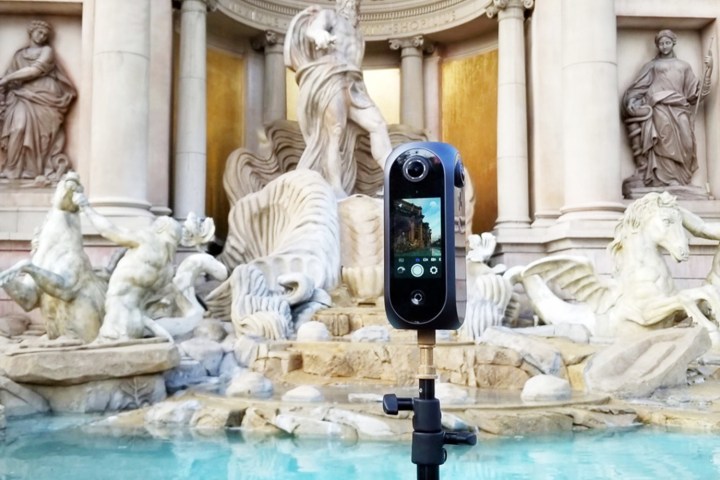
4K seems like a lot of resolution, but wrapped into a 360-degree video, it can still feel a little lacking. To remedy this, Pisofttech is launching the first 360 camera that can stitch and share 8K videos in-camera, thanks to a built-in Android operating system. Announced earlier this year at the Consumer Electronics Show, the Pilot Era, a four-lens camera capable of shooting 8K 360 videos at 25 frames per second (fps) or 4K at an impressive 60 fps, is now funding on Indiegogo.
Pisofttech is most known for its 3D-imaging software, which is found in more 3D cameras than any other software. While the Pilot Era doesn’t have 3D capabilities, the camera’s four lenses and sensors work together to record and stitch 8K spherical video automatically. The four f/2.2 fisheye lenses are placed on each side of the rectangular body. While other pro-level 360 cameras have reached 8k resolution, the processing demands for that higher resolution require using a computer to stitch the files. Cameras like the Insta360 Pro, for example, can do 4K in-camera or 8K when stitching is performed separately. True to the company’s software reputation, the camera also uses algorithms to stabilize the footage and correct any distortions created by merging the four fields of view together.
“Our core technology is the object recognition algorithm, including motion analysis technology, which enables the panoramic camera to detect and interact with images more accurately and makes it smarter,” Pisofttech CEO Adler Shen said in a statement. “This technology will be integrated into the Pilot Era soon, so that the camera can recognize images locally rather than having to upload them to the cloud for recognition and analysis. This will provide a huge performance advantage over systems that rely on the CPU or GPU to run vision algorithms.”
Users can interact with the camera via a small LCD screen, a unique feature not often found on 360 cameras. It also offers voice control and an optional smartphone app can control the camera remotely. Users have a choice of four different preview modes, including fisheye, traditional scrollable 360, little planet, and flattened equirectangular which allows you to see the entire recorded area at once.
Another unique feature is the inclusion of both Wi-Fi and 4G, which can both be used for live-streaming. The camera can’t go live in 8K, but 4K streaming is supported on both YouTube and Facebook.
At just over a pound, the Pilot Era isn’t exactly a featherweight, but it contains dual batteries that can power it for 120 minutes, considerably more than most smaller 360 cams. However, as a high-end device, it is also quite a bit more expensive, with an expected price of $2,600, putting it well out of reach for the average consumer. For professionals who want an easier way to create high-resolution immersive content, however, it could definitely be worth it.
While the Pilot Era makes several big promises, the camera carries potential crowdfunding risk. The project is currently funding on Indiegogo and has already surpassed the original goal. If the development of the camera is successful, early backers could pick up the camera at a discounted $2,000, with shipping expected to start in June.
Updated on May 9, 2019: Added news of Indiegogo funding.
Editors' Recommendations
- Sony claims mini-LED superiority with 2022 8K and 4K TVs
- TCL’s 8K 6-Series mini-LED TVs are shockingly affordable
- Samsung 2020 4K and 8K TV lineup: dizzying and dazzling
- 8K cameras are coming. No, you don’t need one
- Canon EOS R5 will be a video beast, with 8K RAW, 4K at 120 fps




